Class B Airspace: Who Can Enter and How to Get Permission
New private pilots are used to flying into smaller airfields and in uncontrolled airspace, but when your flight plans take you to a major city with a large, busy airport, you will need to know how to navigate the crowded skies and runways. That’s right, it’s time to brush up on your Class B airspace knowledge.
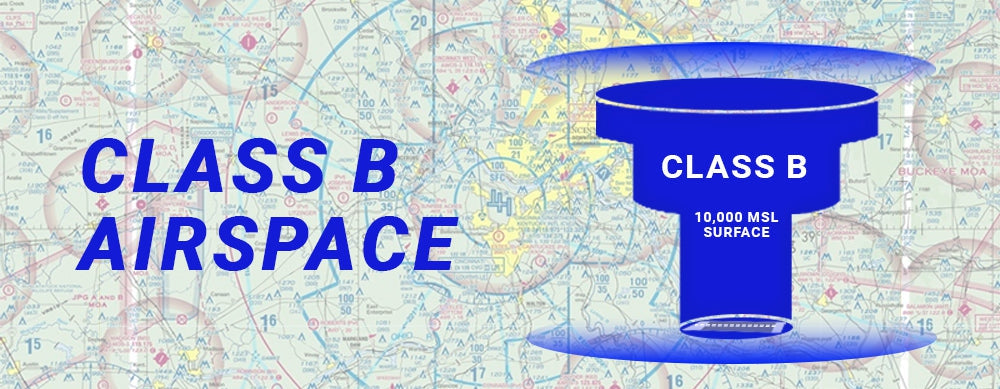
New private pilots are used to flying into smaller airfields and in uncontrolled airspace, but when your flight plans take you to a major city with a large, busy airport, you will need to know how to navigate the crowded skies and runways.
That’s right, it’s time to brush up on your Class B airspace knowledge.
In the United States, Class Bravo airspace can be very intimidating at first, but once you review the requirements, weather minimums, and procedures for operating within this type of airspace, you will be prepared for your next big flight.
What is Class B Airspace?
Class B, or Class Bravo airspace is a category of controlled airspace that surrounds and protects the largest, busiest airports. While student pilots working on obtaining their pilot certificate won't be dealing with Class A, the Class B airspace area is one they are required to fully understand the restrictions on prior to entering.
Large commercial jets fly into Class B airspace all the time, but smaller private planes are also allowed in this airspace provided they meet all the pilot certification and aircraft equipment requirements.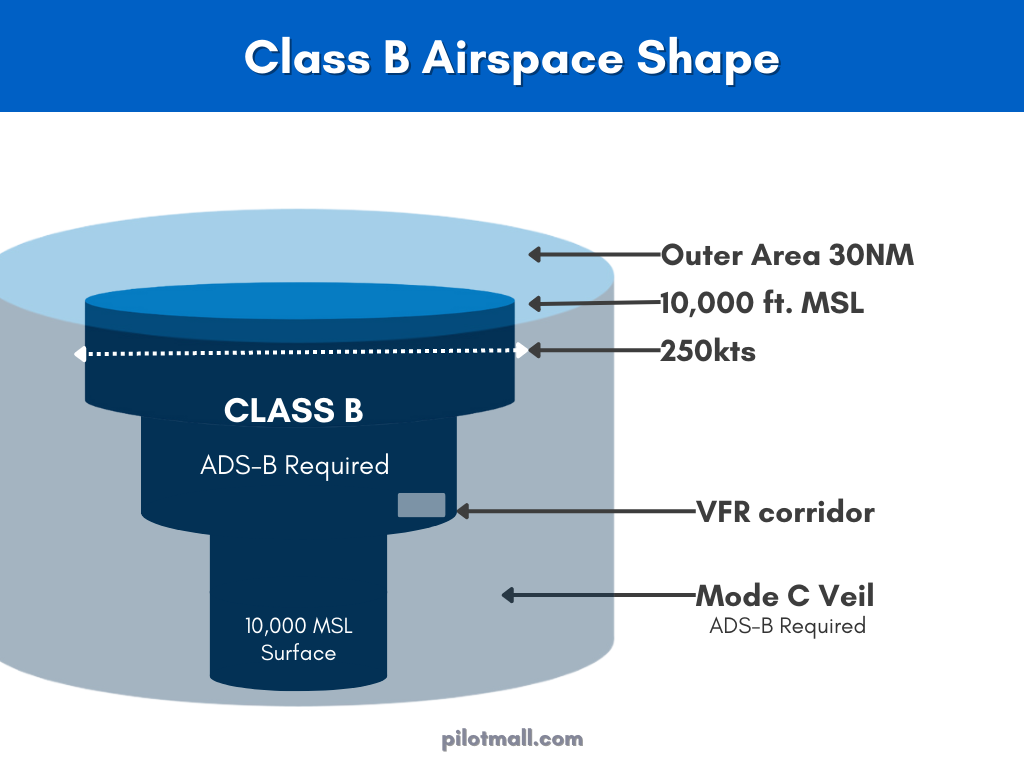
Class B Airspace Dimensions
The shape of Class C airspace is often described as an upside-down wedding cake. Class B airspace has the same distinctive upside-down cake shape, but instead of the two-tiered look of Class C, each Class B airspace is made up of three concentric rings, giving it a three-tiered wedding cake look.
The shape and dimensions of Class B airspace can be somewhat irregular depending on terrain features and the placements of other smaller airports.
When smaller satellite airports are located near a Class B airport, you may see VFR flight corridors or cutouts in the Class B airspace. Other times the smaller airports exist under the shelves of Class B airspace.
The inner shelf of a standard Class B “cake” starts at the surface and extends to the top of the Class B ceiling with a lateral extension of 10nm on all sides of the airport.
The next shelf has a usual floor of 3,000 feet and lateral extension of 20 nm. The final Class B shelf has a floor of 5,000 to 6,000 feet above the surface and extends up to 30 nm laterally from the airport.
Class B Airspace Altitude
Most Class B airspace extends from the surface to 10,000 feet MSL. In some high-altitude airports like Denver, the Class B ceiling extends up to 12,000 feet MSL.
Atlanta is another example of an irregular Class B airspace ceiling altitude. Due to the high volume of air traffic, the Class B ceiling in Atlanta reaches up to 12,500 feet MSL.
Mode C Veil
Each primary airport within Class B airspace is surrounded by a “Mode C Veil” airspace which extends 30 nautical miles laterally from the airport and vertically to an altitude of 10,000 feet MSL.
Regardless of whether they plan to enter Class B airspace, aircraft flying within the Mode C Veil must be equipped with a functional ADS-B Out equipment and a radar beacon transponder that supplies automatic altitude reporting.
The only exceptions to the Mode C Veil regulations are aircraft that were not originally certified with an engine-driven electrical system or that have not subsequently been certified with such a system.
These aircraft can fly within the Mode C Veil but must stay out of Class A, B, and C airspace and below the ceiling of Class B or C.
How to Locate Class B Airspace
Both the vertical and the horizontal boundaries of Class B airspace are marked on VFR sectional maps, as is the Mode C Veil. The horizonal Class B airspace boundaries are depicted using solid blue lines.
Vertical boundaries for each shelf of Class B airspace are communicated with a pair of stacked blue numbers. The top number indicates the ceiling, and the bottom number identifies the floor of that shelf.
Both numbers are in in hundreds of feet MSL. The Mode C veil is marked by a solid magenta circle extending 30nm around the primary Class B airport.
Class B Airspace Requirements
To enter Class B airspace, all aircraft must meet the following requirements:
- ATC clearance required to enter
- Establish and maintain two-way communication prior to entering and while in airspace
- Mode C transponder (within 30 nm, up to 10,000 feet msl)
- Student pilot operations restricted
- Meet weather minimums for VFR flight
Weather Minimums in Class B Airspace
Although Class B airspace has some of the most restrictive equipment and communication requirements, the weather minimums in this category of airspace are less stringent than Class C.
These tighter clearances are possible because since air traffic controllers track VFR aircrafts’ altitude, speed, and headings within Class Bravo airspace, they can control separation of both IFR and VFR aircraft.
Pilots are allowed to fly in Class B airspace under visual flight rules if the following minimum weather conditions exist:
- 3 statute miles of visibility*
- Clear of clouds
*Some Class B airports will approve a request for special VFR clearance (SVFR) down to 1 statute mile of visibility, but this is not guaranteed.
Class B Airspace Speed Limit
Speeds within Class B airspace are limited to 250 knots or less unless otherwise approved by ATC.
Airspeed is also regulated in airspace underlying Class B and in VFR corridors that cut through Class B airspace. Max speed in these areas is 200 knots.
Who Can Enter Class B Airspace?
One of the key differences between Class B and Class C or D airspace is that all pilots need permission to enter Class B airspace. It is not enough to simply advise ATC that your intentions are to enter Class B airspace. You must receive official clearance.
Also, pilots must hold a minimum of a private pilot certification to enter Class B airspace. Sport pilots, recreational pilots, and student pilots are not authorized to operate in Class B airspace.
Can Student Pilots Fly in Class Bravo Airspace?
Since Class B airspace is so congested and busy, it is not an ideal learning environment for new pilots. Student pilots who do not yet hold at least a private pilot certificate are not allowed to fly in Class B airspace without prior approval.
Students who are studying to get their private pilot certification can receive special training and a 90-day instructor endorsement that allows them to conduct solo flights into some Class B airspaces.
Even with the special endorsement, some of the busiest Class B airports like Atlanta, JFK, Ronald Reagan, Chicago O’Hare, Los Angeles, and San Francisco are off-limits to students due to safety concerns.
Do You Have to Pay to Fly into a Class B Airport?
If it’s your first time flying into a Class B airport, prepare your wallet because you will need to pay landing and parking fees. The fee rates vary by airport but are usually calculated based on the size or type of your aircraft, when you land, and how long you stay.
Expect to pay a basic landing fee, a handling fee to the FBO, and a parking fee if you stay longer than the allotted timeframe covered by your basic landing fee.
The best strategy for mitigating fees is to do some research while planning your flight. Find out if the Class B airport assesses extra surcharges for flying in and out during peak times.
You can also check how many hours of parking are included with your basic landing fee and what the hourly rate is for additional time. Finally, ask about possible fee reductions given to pilots who purchase fuel.
How to Successfully Taxi at a Class B Airport
Navigating the skies surrounding a Class B airport is hard enough, but the fun doesn’t stop when you touch down. The final test is navigating the intricate maze of runways and taxiways of the United States of America’s largest airports.
As soon as you clear the runway and switch to ground control, be prepared for the controller to spit out a long string of directions to the ramp including where to hold short and which aircraft to cross behind.
If this is your first time flying into a new Class B airport, the directions can be intimidating, but again, some pre-planning goes a long way.
Study the airport diagram prior to your flight so you have at least a basic understanding of the layout. If you have Microsoft Flight Simulator and the Just Flight Real Taxiways USA add-on, you can practice flying in and out plus navigating between the ramp and the runway using the signs that match their real-world placement.
Finally, when the big day comes to make your real-world flight, have your kneeboard ready so you can quickly write down the taxi instructions you are given. Still feeling a little flustered and worried about making a mistake? There is no shame in asking ATC for a progressive.
With a progressive taxi, the controller will walk you through your taxi route step by step rather than just giving it to you all at once. Remember, when in doubt, ask ground control for clarification. It is far better than risking an inadvertent runway incursion.
How to Get Approval to Enter Class B Airspace
When flying into or out of Class B airspace, pilots must contact ATC and receive clearance to operate within the airspace. This includes flights to and from satellite airports.
As you plan your flight communications, remember to allow enough time to reach out to ATC and receive Class B airspace approval prior to arriving at the Class B airspace boundary line.
If you wait too long, you will have to divert and remain outside the airspace until you are cleared to enter.
Radio Procedures for Class B Airspace
- State your call sign, position, altitude, destination, and request “clearance into Class Bravo.”
- Unlike Class C airspace, a simple acknowledgement by ATC is not sufficient for you to enter Class B airspace. You must also receive clearance and a unique transponder squawk code to enter. Remain outside Class B airspace until you hear the controller give you a squawk code and specifically state that your callsign is “cleared to enter Class B airspace.”
- When departing an airport with an operating control tower in Class B airspace, you must establish two-way radio communications with control and receive clearance for takeoff. The controller will assign you a standard departure path for VFR or you will fly a published standard instrument departure procedure (SID) for IFR. Once you are in the air, you must maintain communications with ATC while you are within Class B airspace.
- If you are taking off from a nontowered satellite airport within Class B airspace, establish two-way radio communications and get a squawk code from ATC as soon as possible after departure.
Takeaways
In the United States, with all the large jets, heavy traffic, and stringent communications requirements of Class Bravo airspace, it’s no wonder some private pilots are inclined to avoid it altogether.
Still, once you learn the rules, practice the communications, and study the airport diagrams, you will be ready to navigate Class B with the pros.
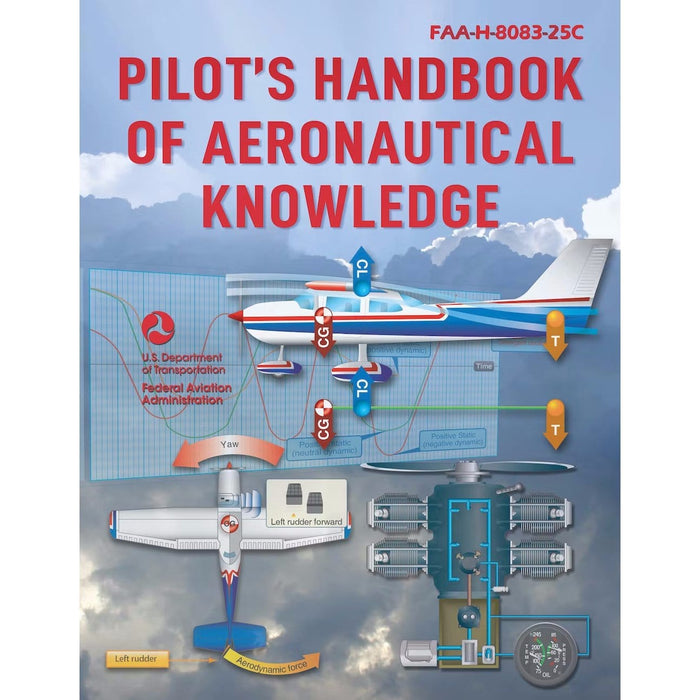
|
FAA Pilot's Handbook of Aeronautical Knowledge FAA-H-8083-25C"The FAA Pilot's Handbook of Aeronautical Knowledge is a key resource for fundamental aviation knowledge for pilots. Updated in 2023, this essential handbook covers all the information needed to pass each FAA Knowledge Exam and Practical Test and to safely operate an aircraft. |
Want a quick refresher on the other categories of airspace? Check out these articles:
- Class A Airspace: and How it Differs from All Other Categories of Airspace
- Class B Airspace: Who Can Enter and How to Get Permission
- Class C Airspace: All the Details You Need to Know
- Class D Airspace: Everything You Need to Know
- Class E Airspace: The Logic Behind It (Guide)
- Class G Airspace: Everything You Need to Know























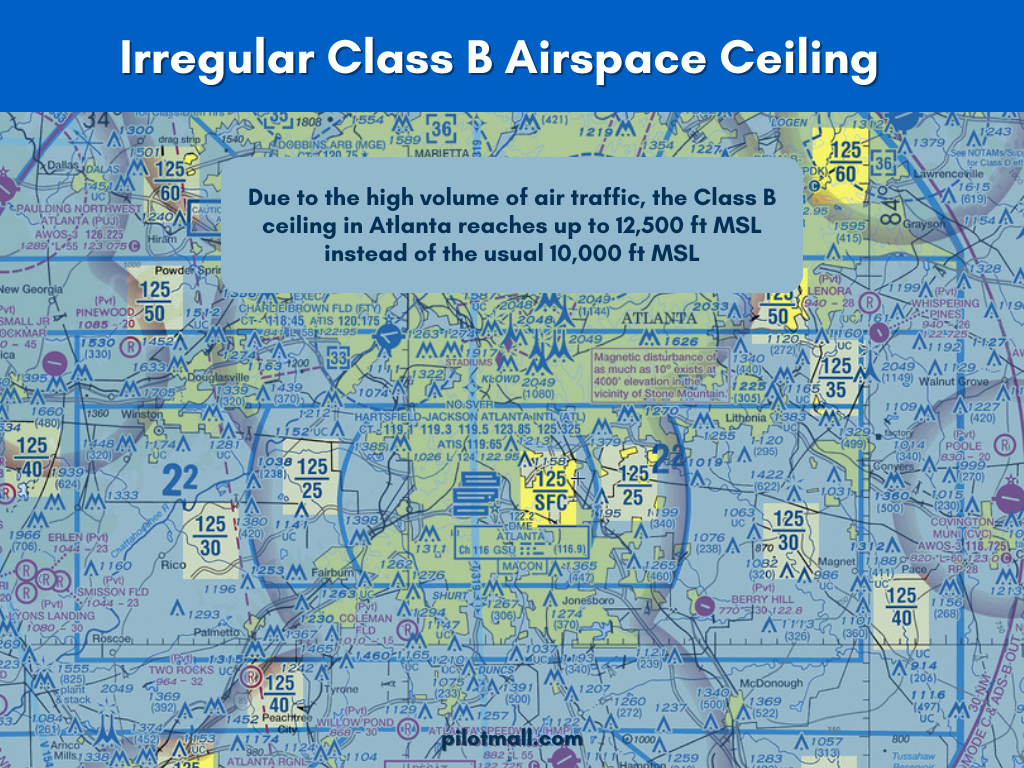
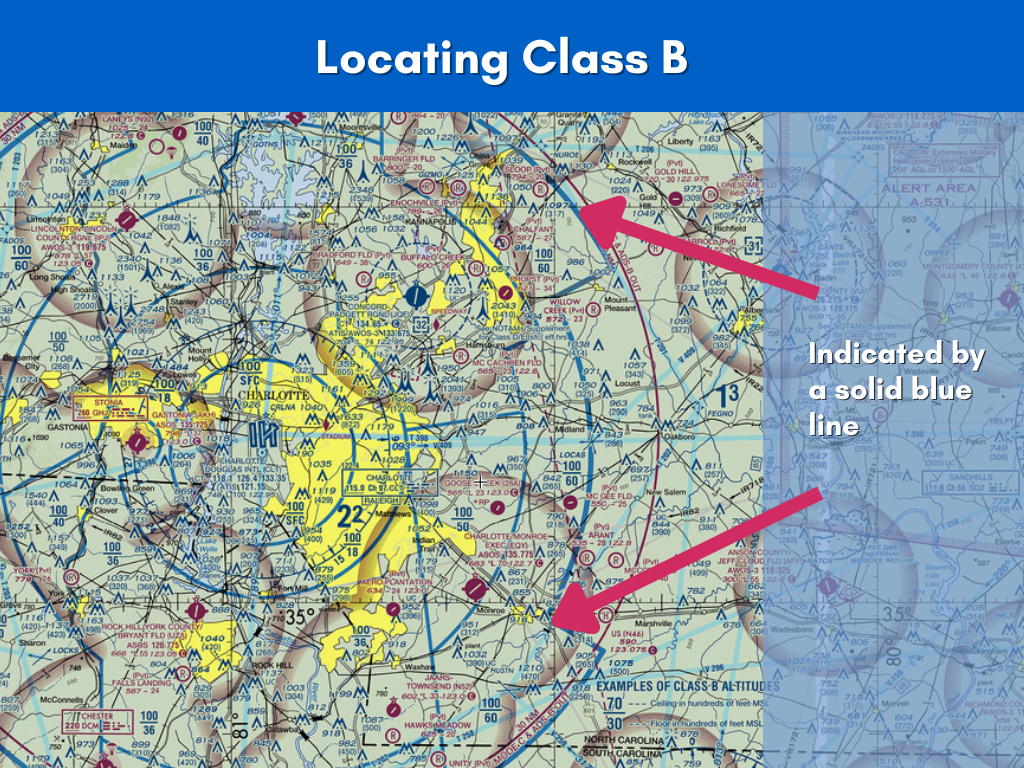
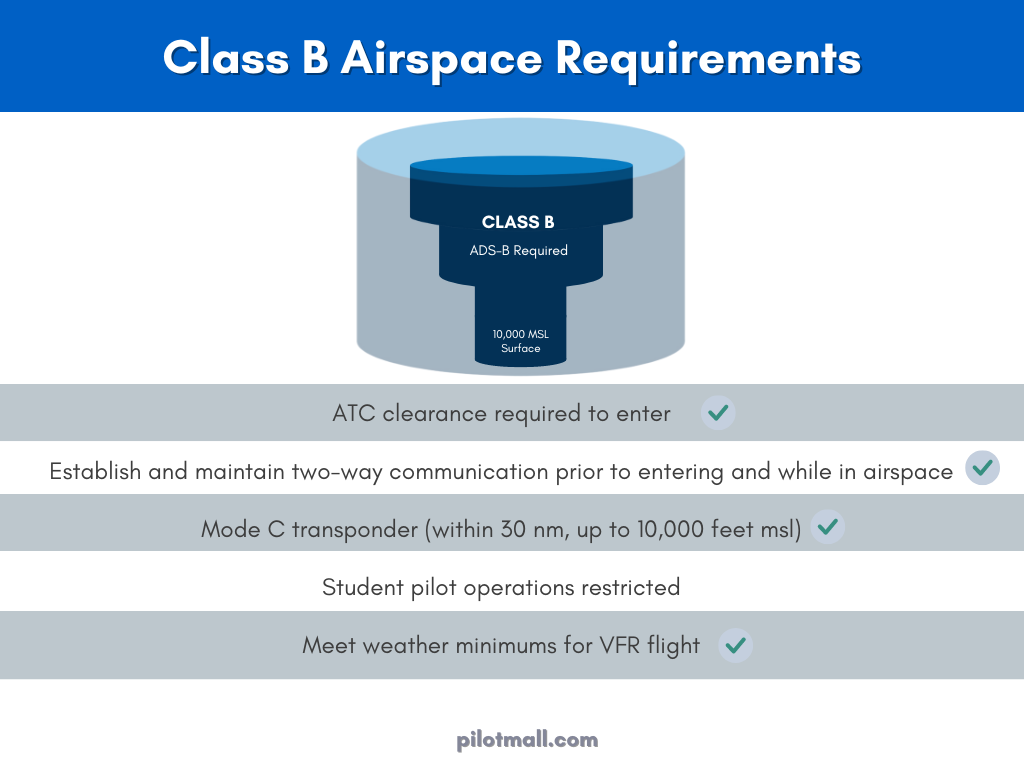




3 comments
There is no 250kt speed limit in bravos.
There is a 250kt speed limit under 10,000 MSL, and its common for a lot of bravos to have a ceiling at 10,000 MSL, so the 2 might get mixed up.
For example KSLC has a ceiling that goes up to 12,000 MSL so you can still fly faster than 250kts in a bravo.
14 CFR § 91.117
One need not “hold a minimum of a private pilot certification to enter Class B airspace” if one has the proper endorsements. Talk to a qualified and familiar Sport Pilot instructor for help navigating 14 CFR to the correct information :-)
several Bravos have a ceiling below 10k. Miami, NYC, etc. those dont go to 10, don’t know why. i had an RA in NYC with a cirrus at 8.5k that wasnt talking to anybody.